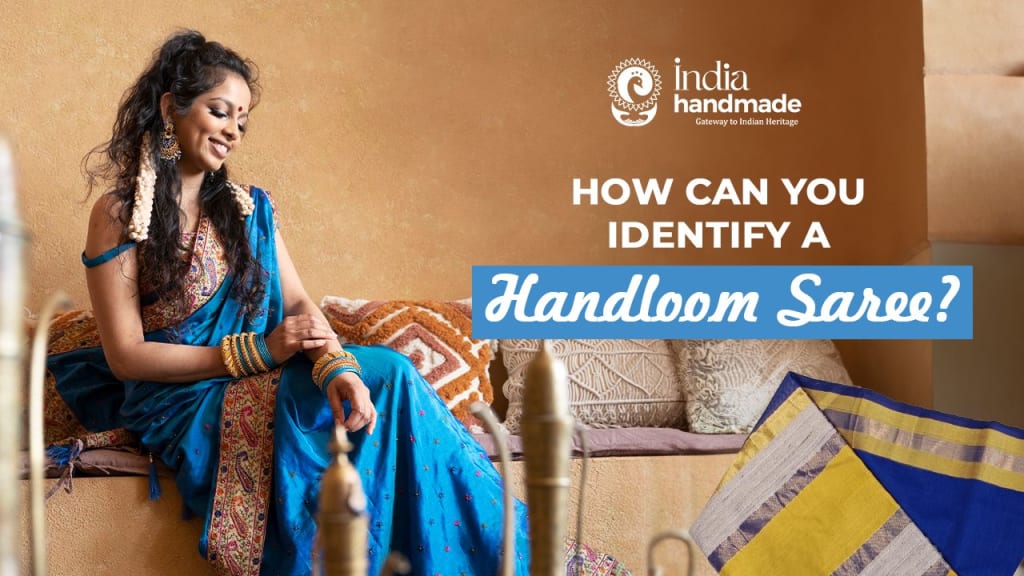How Can You Identify a Handloom Saree?
Why Is a Handloom Saree Unique?

Handloom sarees, also known as handwoven sarees, are wearable artwork. Skilled weavers handcraft them over days, sometimes weeks, using their human ability and experience. Here’s how to distinguish between handwoven and power loom sarees; they vary significantly.
What Is a Handloom?
In textile weaving, a loom serves as a piece of machinery. On the other hand, electricity mechanizes and powers a power loom, while the weaver manually controls a handloom. The weaver sits at one end of the handloom and arranges the weft threads in “shuttles,” passing them across the breadth of the warp yarns to create the textile. The handloom stretches the fabric’s length, known as the warp.
There are three types of handlooms: pit looms, stand looms and frame looms. The Ministry of Textiles, Government of India, defines a handloom as one that requires human interaction in a broad sense. Many weavers in Tamil Nadu use pit looms to create handwoven Kanchipuram silk sarees and award-winning innovations.
The weaver partially inserts these handlooms, as their name implies, into openings excavated in their home floor. The weaver positions the beam holding the warp yarns just slightly above the floor, and places the handloom pedals, also known as “treadles,” inside the pit. Seated on the floor, the weaver uses his feet to press the treadles, thereby controlling the loom.
Why Is a Handloom Saree Unique?
An expert craftsman intertwines the warp and weft threads on the loom to create a handloom saree. It takes decades to develop this proficiency and skill level, and the family passes down much of the information from one generation of weavers to the next.
The world’s best handloom industry previously belonged to India. Gujarat woven ancient Egyptian cotton textiles and Bengali cotton played a crucial role in the economy until the eighteenth century. Karl Marx noted that “the handloom and the spinning wheel...were the pivots of that society’s structure.” Even now, behind agriculture, the handloom sector employs the second-highest number of people in rural India.
A handcrafted item is the culmination of all a weaver has learned; the colours and patterns reflect his taste; the minute variations in the weave indicate where he paused; and the minuscule knots indicate where he skilfully repaired frayed strands. Since the weaver constantly modifies the colours or patterns, each handloom saree is unique, even in sarees with the same design.
A handcrafted saree is more than just the weaver’s work. Around 50 craftsmen create a single handcrafted Kanchipuram silk saree, which takes weeks to create.
How Can You Identify a Handloom Saree?
Sometimes, brands label even sarees made on power looms as “handloom,” making it challenging for customers to distinguish hand-made textiles. Recall that power loom textiles are significantly less expensive since they are machine-made. Because power loom textiles have overtaken the market, handcrafted textiles made by weavers are now worth less.
The knowledge of and demand for handcrafted garments decline as the consumption of ever-cheaper clothing increases. Since handloom weaving is often a talent handed down from father to child, when an artisan leaves spinning to seek a more fulfilling career, it affects not just our generation but future generations.
However, discriminating buyers may still identify a handwoven saree simply by feeling and touching it. Here are some things to check for the next time you purchase a handwoven Kanchipuram silk saree:
• There are some irregularities in handwoven sarees.
People run handlooms, whereas machines operate power looms. While handloom sarees always show evidence of human participation, the patterns of power loom sarees are perfectly regular.
For instance, you could see an additional weft thread or a little variation in the motif’s size in handloom sarees. A day and a half is enough time for a power loom to create two silk sarees. In contrast, a weaver may spend several days working on a saree; handwoven Kanchipuram wedding silk sarees may take weeks to complete. When you examine a handloom saree closely, you will see almost invisible knots that show where the weaver paused while making the sari. These signs are not defects; they are proof that a person with decades of experience and labour put a lot of effort into making your garment.
• Handloom sarees feel better in your hands.
Machine-made sarees tend to be stiff due to the firmly woven threads. On the other hand, due to their looser weave, handloom sarees are more flowing. Because of this, handwoven Kanchipuram silk sarees have a luxuriant texture and feel more light.
• There are pinholes in handloom sarees.
The weaver fixes the ends of the weft with small pins while weaving the saree, then stretches the final portion. This makes weaving less prone to creases. Looking closely, you may notice a few little pinholes clustered at the border. This demonstrates the saree’s handloom origin.
• A handloom saree’s selvedge is more textured.
The hem of handwoven Kanchipuram silk sarees have a more unfinished, handcrafted appearance. If you compare the hem of a power loom saree with a handwoven one, you will notice that the power loom selvedge is perfectly straight.
Summing Up
The garment’s originality and the skill of the individual who made it are often factors in the definition of luxury in fashion. In this context, isn’t a handloom silk saree one of the most valuable possessions? Let us know your viewpoints in the comments.
About the Creator
Enjoyed the story? Support the Creator.
Subscribe for free to receive all their stories in your feed. You could also pledge your support or give them a one-off tip, letting them know you appreciate their work.





Comments
There are no comments for this story
Be the first to respond and start the conversation.